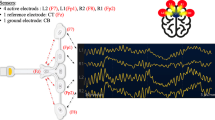Abstract
Objective
Optimization of combining electroencephalography (EEG), short latency somatosensory evoked potentials (SLSEP) and transcranial Doppler (TCD) techniques to diagnose brain death.
Methods
One hundred and eleven patients (69 males, 42 females) from the major hospitals of Zhejiang Province were examined with portable EEG, SLSEP and TCD devices. Re-examinations occurred ≤12 h later.
Results
The first examination revealed that the combination of SLSEP and EEG led to more sensitive diagnoses than the combination of SLSEP and TCD. Re-examination confirmed this and also revealed that the combination of TCD and EEG was the most sensitive.
Conclusion
The results show that using multiple techniques to diagnose brain death is superior to using single method, and that the combination of SLSEP and EEG is better than other combinations.
Similar content being viewed by others
References
Ad Hoc Committee of the Harvard Medical School to Examine the Definition of Brain Death, 1968. A definition of irreversible coma. JAMA, 205(6):337–340. [doi:10.1001/jama.205.6.337]
Cabrer, C., Dominguez-Roldan, J.M., Manyalich, M., Trias, E., Paredes, D., Navarro, A., 2003. Persistence of intracranial diastolic flow in transcranial Doppler sonography exploration of patients in brain death. Transplant. Proc., 35(5):1642–1643. [doi:10.1016/S0041-1345(03)00692-4]
Cheng, W.L., Lin, K.C., 2008. Supplementary tests for confirmation of brain death. J. Zhejiang Univ. Sci. B, 9(11):921–922. [doi:10.1631/jzus.B0870001]
Facco, E., Casartelli Liviero, M., Munari, M., Toffoletto, F., Baratto, F., Giron, G.P., 1990. Short latency evoked potentials: new criteria for brain death? J. Neurol. Neurosurg. Psychiatry, 53(4):35l–353.
Facco, E., Munari, M., Gallo, F., Volpin, S.M., Behr, A.U., Baratto, F., Giron, G.P., 2002. Role of short latency evoked potentials in the diagnosis of brain death. Clin. Neurophysiol., 113(11):1855–1866. [doi:10.1016/S1388-2457(02)00259-6]
Grigg, M.M., Kelly, M.A., Celesia, G.G., Ghobrial, M.W., Ross, E.R., 1987. Electroencephalographic activity after brain death. Arch. Neurol., 44(9):948–954.
Kuo, J.R., Chen, C.F., Chio, C.C., Chang, C.H., Wang, C.C., Yang, C.M., 2006. Time dependent validity in the diagnosis of brain death using transcranial Doppler sonography. J. Neurol. Neurosurg. Psychiatry, 77(5):646–649. [doi:10.1136/jnnp.2005.076406]
Luo, B.Y., Yuan, Q.M., Tang, M., Jiang, M.Y., Qiu, Y.Q., 2006a. Electroencephalogram in the diagnosis of brain death. Chin. J. Neurol., 39(8):532–535 (in Chinese).
Luo, B.Y., Zhang, L.Y., Jiang, M.Y., Wang, J.W., Qiu, Y.Q., 2006b. The application of transcranial Doppler in the evaluation of brain function in deeply comatose patients. Chin. J. Intern. Med., 45(2):116–118.
The National Ministry of Health’s Drafting Group of the Standard Judgment of Brain Death, 2003. The technique standard of judgment of brain death (opinion soliciting draft). Chin. J. Med., 83(3):262 (in Chinese).
Waters, C.E., French, G., Burt, M., 2004. Difficulty in brainstem death testing in the presence of high spinal cord injury. Br. J. Anaesth., 92(5):760–764. [doi:10.1093/bja/aeh117]
Wjdicks, E.F.M., 2001. Brain Death, 1st Ed. Lippincott Williams & Wilkins, Philadelphia, p.285.
Young, G.B., Shemie, S.D., Dong, C.J., Teitelbaum, J., 2006. Brief review: the role of ancillary tests in the neurological determination of death. Can. J. Anaesth., 53(6):620–627.
Author information
Authors and Affiliations
Corresponding author
Rights and permissions
About this article
Cite this article
Wang, K., Yuan, Y., Xu, Zq. et al. Benefits of combination of electroencephalography, short latency somatosensory evoked potentials, and transcranial Doppler techniques for confirming brain death. J. Zhejiang Univ. Sci. B 9, 916–920 (2008). https://doi.org/10.1631/jzus.B0820123
Received:
Accepted:
Published:
Issue Date:
DOI: https://doi.org/10.1631/jzus.B0820123
Key words
- Brain death
- Electroencephalography (EEG)
- Short latency somatosensory evoked potentials (SLSEP)
- Transcranial Doppler (TCD)




